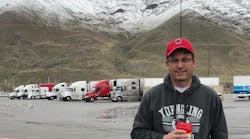My wife, Letty and I recently completed a 7,700-mile cross-country road trip over six weeks. The lessons I learned in the first 2,000 miles and blogged about earlier, held true throughout our excursion.
As a refresher, our mode of transportation is a Ford Super Duty pickup truck pulling a 40-foot, fifth-wheel camper. Before the trip started I committed to driving slowly. In this case it meant 64 mph. As I discovered in the first 2,000 miles, driving slowly not only resulted in better fuel economy but also it caused less wear and tear on my body. (I am sure Letty will vouch for the fact that by driving slowly I was less tired and crabby after a day on the road.)
This was especially noticeable on a couple of days when I drove 550 miles in a single day. Sure I could have driven that far at a faster speed, but I am convinced I would have been more worn out. Driving slowly also meant less stress. Basically, I got in the right lane, stayed there and was not passing people every few miles.
The second thing I can confirm is that on any two or more days there can be a huge variance in fuel economy. This reinforces the learning from Run on Less that conditions matter. My lowest fuel economy was 8.5 mpg and that occurred on a day when I was driving through the mountains, directly into a sustained wind of 30 mph. However, on the day I spent going across the flats of California I got to 12.5 mpg. I don’t even want to talk about what my fuel economy was the day it took us four hours to travel the 50 miles across Los Angeles. As all truckers know, stop-and-go traffic is a killer on fuel economy not to mention being quite stressful.
Driving our version of a “big rig” I became more acutely aware of non-driving issues such as parking. When you are on the road in a truck, finding parking can be hard and this not only relates to finding parking for mandated rest periods but also for things like finding food or shopping for a shirt or toothpaste. I always knew parking was an issue, but I really underappreciated how much of a problem it really was until we traversed the country. In many cases, the truck stop becomes the drivers only option which means drivers who want to stay fit have to get creative about what they eat and how they work out. It's not like they can pull into a city or state park and jog the trails.
Finally, I learned something that all truckers probably already know: driving a truck is a tough job and other people on the road need to be kinder to truck drivers. I can’t tell you how many times during our journey someone cut too close in front of me expecting me to be able to stop on a dime even though I was carrying a lot of weight. Even at a quarter of what a truck weighs, it was often very hard to stop in the short distance the driver of the car cutting in allowed.
We all need to keep reminding folks out on the roads that they need to not pass trucks on the right (it is too hard to see someone there), to move to the left if a truck is stopped along the side of the road, be patient, take your time and not drive so aggressively.
Basically, we need people to be kinder to truckers. I think that will make our roads safer and make driving better for the approximately 2 million truck drivers on the road and for all of us.
While Letty and my cross-country adventure is over, this is not the end of our travels. I’ll be looking for you out on the road and will continue to share lessons learned. And, of course, if our paths cross I am always happy to hear about what you are doing to improve fuel economy and freight efficiency.



